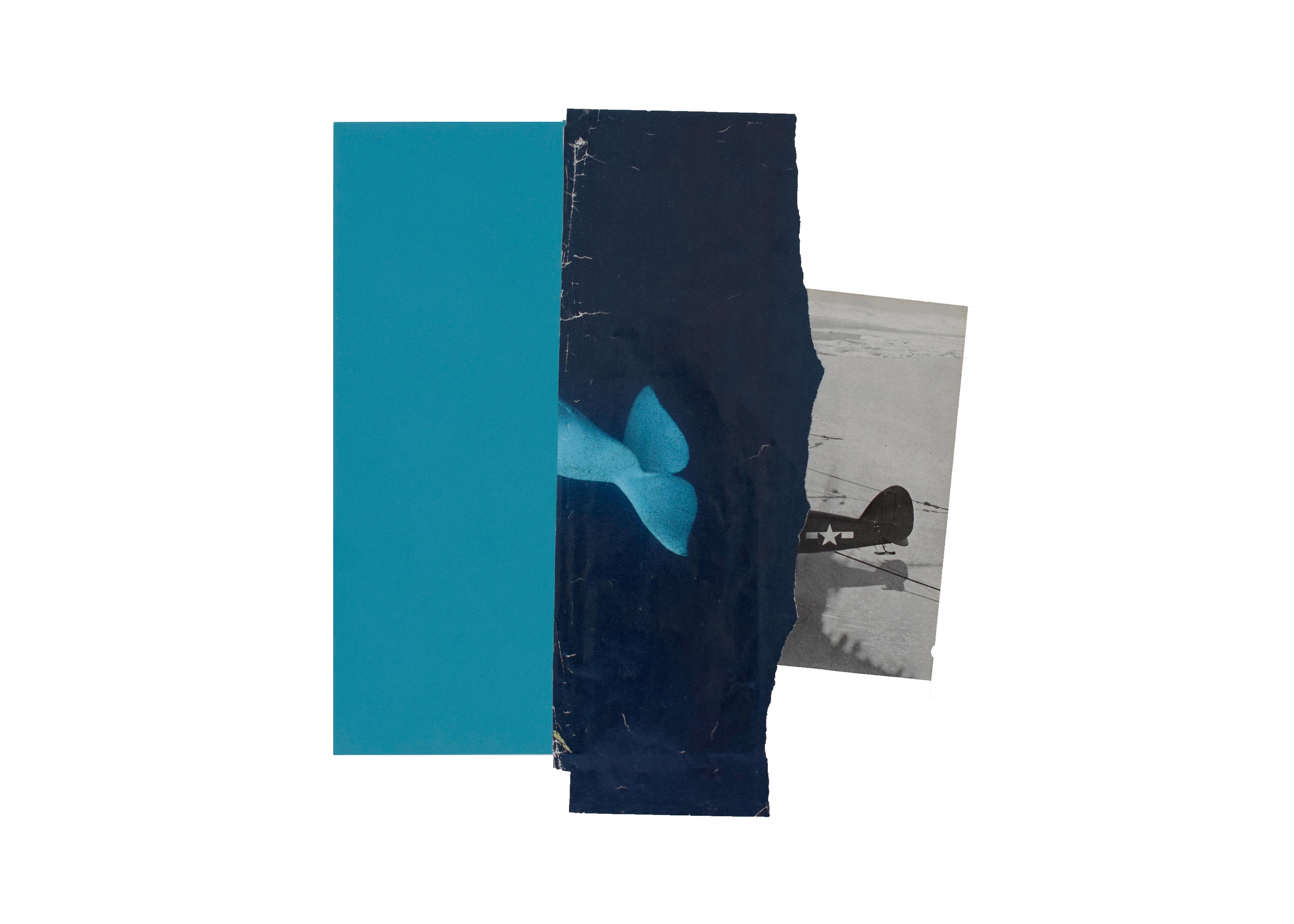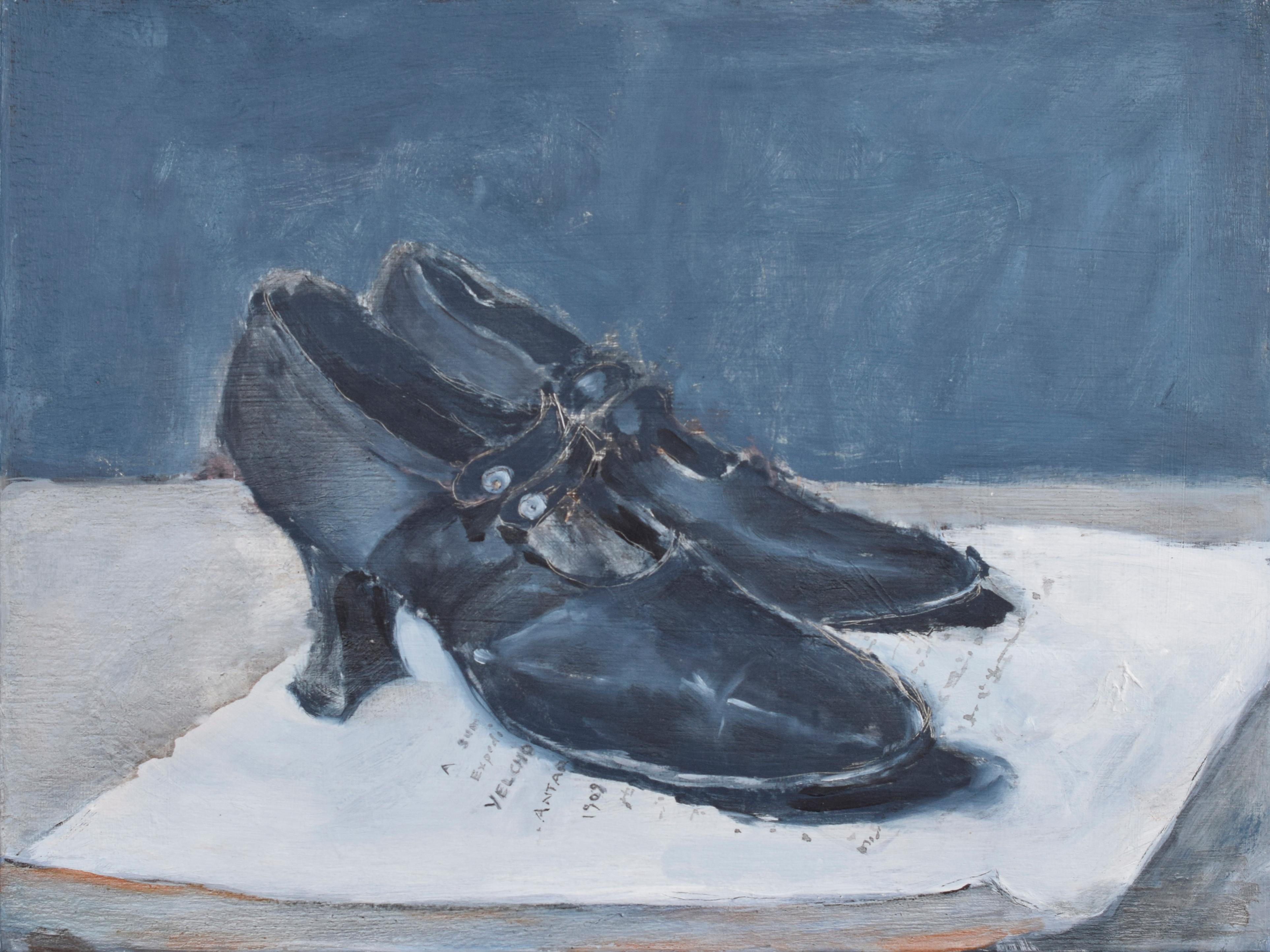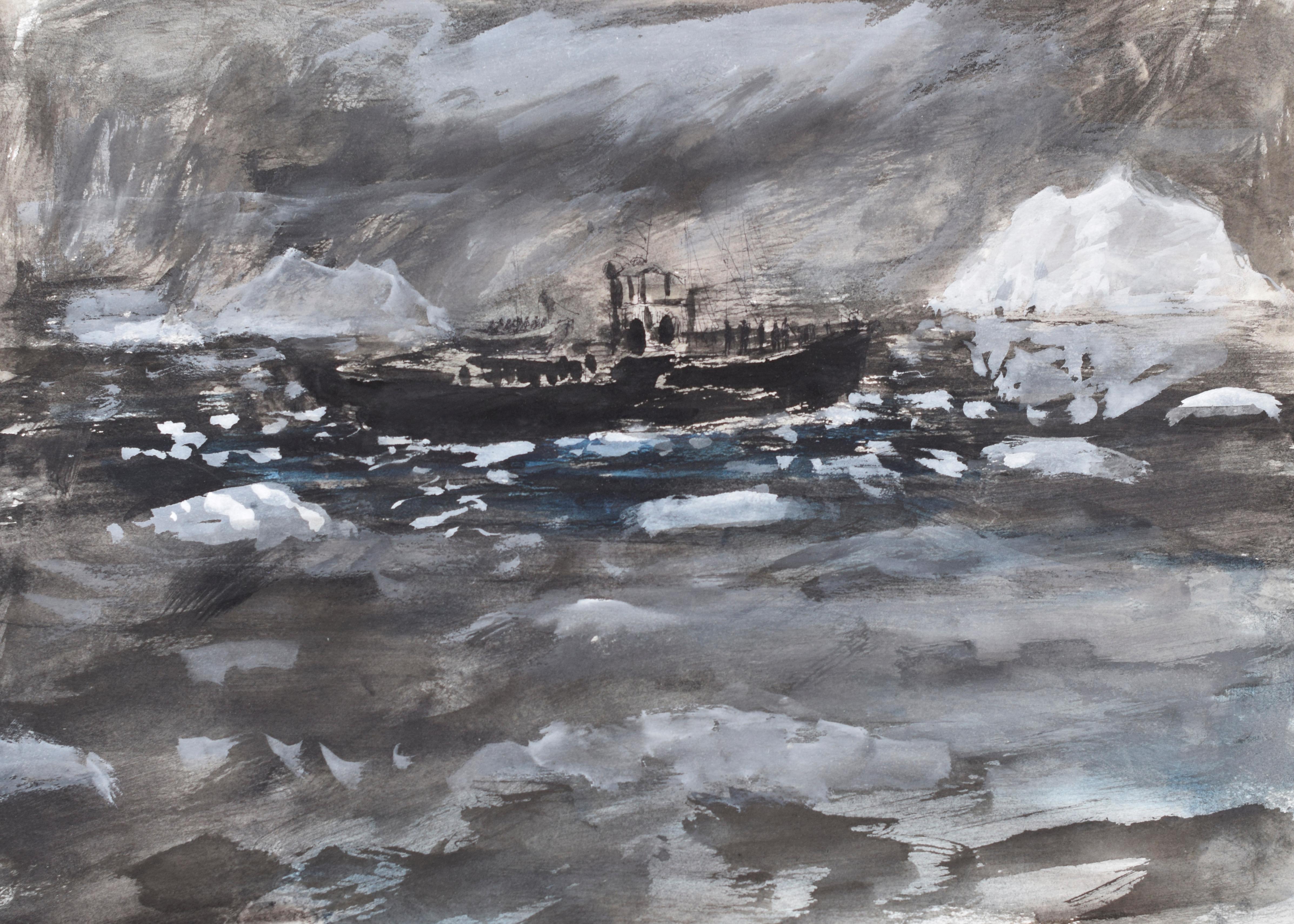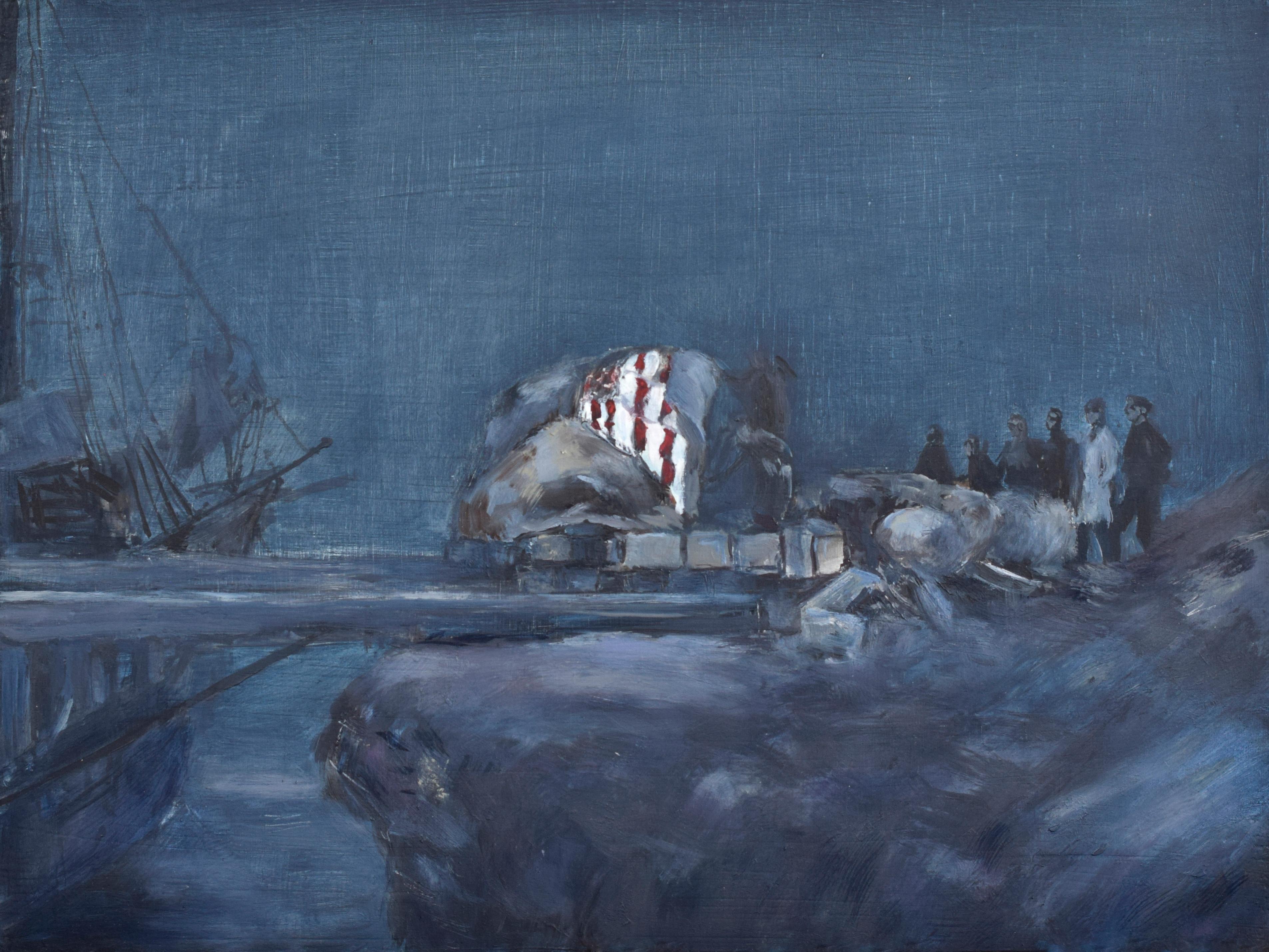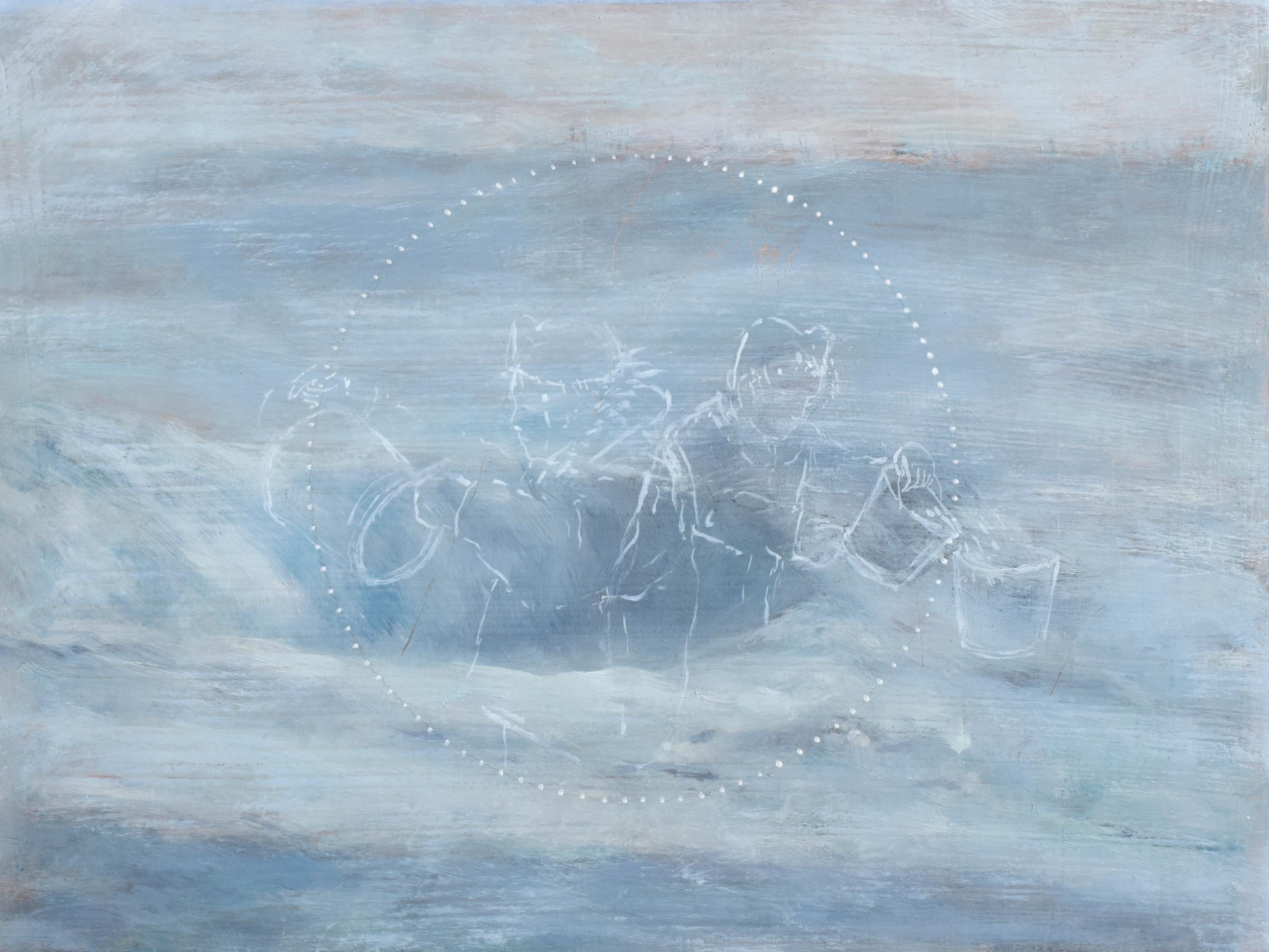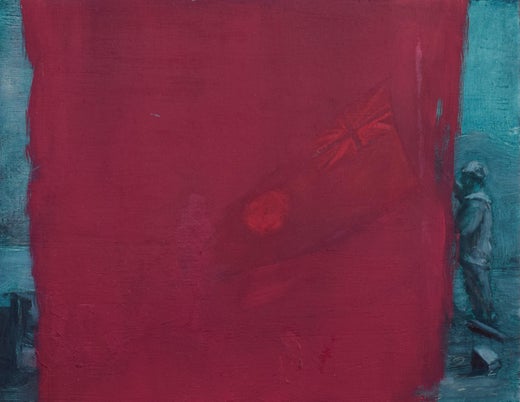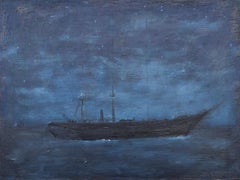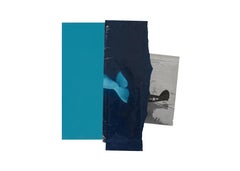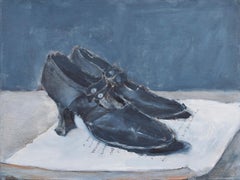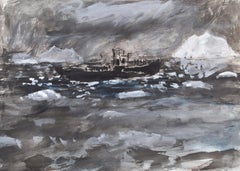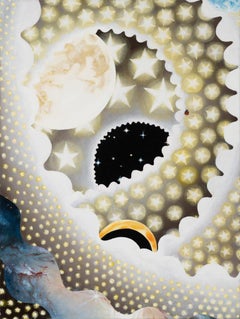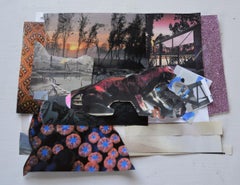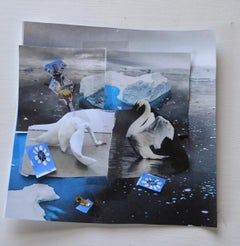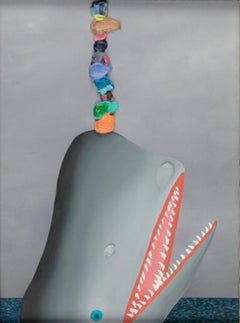Want more images or videos?
Request additional images or videos from the seller
1 of 4
Jessica Houstoninstead of a narrow bight...2022
2022
$1,800
£1,373.45
€1,562.40
CA$2,527.78
A$2,766.35
CHF 1,461.78
MX$33,018.27
NOK 18,654.08
SEK 17,060.67
DKK 11,670.32
About the Item
A group of figures heads for icy distant mountains. A familiar enough scene of polar explorers hauling their sledges. Yet somehow this does not quite fit the heroic mold. The ice and sky are tinged a movie musical pale blue and their gear is a bit too colorful for the era of man-hauling. And then there’s the sled, piled high not with boxes of supplies but with a jumbled heap of antiquities: Greek Athenas, bits of a coliseum, a ship’s great wheel. In Jessica Houston’s collage “The Long Haul,” the explorers drag history itself into the great beyond, their backs turned from their absurd load. But we take in the entire scene.
In her suite of works, Over the Edge of the World, Houston uses oil on wood, ink on paper, and collages of found images, many from National Geographic Magazine, to rearrange the evidence – and thus history’s possibilities.
Houston joins visual artists such as Judit Hersko, Katja Aglert, and Isaac Julien who have been inspired by the explorers of the past. Like them, she draws, in part, on the singular tradition of polar exploration narratives as well as fictions such as Ursula Le Guin’s “Sur” (1981), a utopian feminist hoax in which a party of South American women reach the South Pole in 1909, two years before the official arrival of European explorers. Le Guin’s explorers do not feel compelled to leave any written record or physical proof of their presence at the South Pole. If Le Guin’s women might have made it, what other traces have been missed?
Collage can work alongside alternative history: it interprets, interrupts, and rearranges. It questions the completed whole, instead emphasizing composition and relation. Collage suggests it all might be … otherwise. Houston’s collages flaunt their second nature. Yet what they show remains somehow plausible. You want to believe what you’re beginning to see.
In “A life Attuned to Larger Rhythms” Houston grids out rectangles of captured images to overwhelm the eye as the polar environment itself might (whiteout is a paradoxical species of optical overstimulation). Through the strangely ordered confusion of an ice survey grafted atop a chessboard, the mind begins to recognize new connections, emergent shapes: a different future? In “Launching Strategy” a yellow-orange pyramid balances garishly atop a tent. Which came first, the realist tent or the Platonic shape? Can we ever be sure that we’re not already seeing through premade abstractions? Or is it that baggage we’ve been dragging along?
In “Architecture of the Anthropocene” and “Red Blood, Red Earth” Houston reroutes visually symbolic through-lines between women and non-European people and the official history in which they appear dimly or not at all. A full-skirted woman holds onto the tether of a kite that seems to pull her upwards towards a weather balloon floating above an Antarctic base’s radio tower; a row of tropical workers wielding pickaxes folds into the trajectory of a sailor aiming a bow and arrow at an iceberg stained with red. These are not people or images normally associated with polar discovery. But shouldn’t they matter?
“Territory Over Land” strips in a scene from a painted depiction of the tropics, possibly from one of Captain James Cook’s circumnavigations. “Captain Cook’s Legacy” more directly confronts an official portrait of Cook with the torn-in eyes from what can only be described as the explorer’s anonymous dark Other. The hybrid portrait is a kind of contact zone. “Henson and Peary – Past Entanglements” is a cooler, less volatile twin portrait of disputed discoverer of the North Pole Robert Peary and his African-American second in command, Mathew Henson, who was consistently erroneously referred to as Peary’s “manservant.”
Houston re-mystifies polar landscapes that have become through tourism and even the most well-meaning nature documentaries too familiar, too smooth and clean, replete with aesthetically pleasing icebergs and bright icescapes under perfect blue skies. But the poles have 6 months of darkness too. Houston deepens and complicates received images, but without reviving heroic dramas of survival against a blank, enemy ice. The ice in the “Sur” paintings is grimy, oily, swirling with evocations of masted ships swallowed up in dark seas. History is a risk. Survival is not guaranteed.
- Creator:Jessica Houston (1970, American)
- Creation Year:2022
- Dimensions:Height: 9 in (22.86 cm)Width: 12 in (30.48 cm)
- Medium:
- Movement & Style:
- Period:
- Condition:
- Gallery Location:Montreal, CA
- Reference Number:1stDibs: LU47610875592
Jessica Houston
Jessica Houston (MA, Columbia University) has traveled from pole to pole, using color and light to entangle and provoke questions related to our changing natural world, and our nature within it. She has created site-specific works for the NJ MOCA (NJ); the Castello di Corigliano (Puglia, Italy); and The Albany Airport (Albany, NY). Select exhibitions include Art Mûr Gallery, Montréal, Canada; The Hyde Collection Museum, Glens Falls, NY; and The Latimer House Museum, New York, NY. She has been invited to residencies at The Albers Foundation and CAMAC Center for Art, Science and Technology in France. Her works are funded by The Canada Council for the Arts and are in the collections of La collection Prêt d’œuvres d’art, Musée National Des Beaux-Arts du Quebec; Bibliothèque et Archives nationales du Québec (BAnQ), Montréal, Québec; Bank of Montréal, Toronto; and the Consulate General of Monaco, Montréal. She has lectured at The Art Institute of Florence; Columbia University; Concordia University; and OCAD University.
About the Seller
5.0
Vetted Professional Seller
Every seller passes strict standards for authenticity and reliability
Established in 1996
1stDibs seller since 2014
105 sales on 1stDibs
- ShippingRetrieving quote...Shipping from: Montreal, Canada
- Return Policy
More From This Seller
View AllOf the return voyage...
By Jessica Houston
Located in Montreal, Quebec
“Of the return voyage there is nothing to tell… In 1912 all the world learned that the brave Norwegian Amundsen had reached the South Pole; and then, much l...
Category
2010s Contemporary Mixed Media
Materials
Oil, Wood Panel
No Such Border
By Jessica Houston
Located in Montreal, Quebec
A group of figures heads for icy distant mountains. A familiar enough scene of polar explorers hauling their sledges. Yet somehow this does not quite fit the heroic mold. The ice and...
Category
2010s Contemporary Mixed Media
Materials
Archival Paper, Magazine Paper
A summary report...
By Jessica Houston
Located in Montreal, Quebec
“A SUMMARY REPORT OF THE YELCHO EXPEDITION TO THE ANTARCTIC, 1909-1910. Although I have no intention of publishing this report, I think it would be nice if a grandchild of mine, or somebody’s grandchild, happened to find it some day; so I shall keep it in the leather trunk in the attic, along with Rosita’s christening dress and Juanito’s silver rattle and my wedding shoes...
Category
2010s Contemporary Mixed Media
Materials
Oil, Wood Panel
Taking Place
By Jessica Houston
Located in Montreal, Quebec
A group of figures heads for icy distant mountains. A familiar enough scene of polar explorers hauling their sledges. Yet somehow this does not quite fit the heroic mold. The ice and sky are tinged a movie musical pale blue and their gear is a bit too colorful for the era of man-hauling. And then there’s the sled, piled high not with boxes of supplies but with a jumbled heap of antiquities: Greek Athenas, bits of a coliseum, a ship’s great wheel. In Jessica Houston’s collage “The Long Haul,” the explorers drag history itself into the great beyond, their backs turned from their absurd load. But we take in the entire scene.
In her suite of works, Over the Edge of the World, Houston uses oil on wood, ink on paper, and collages of found images, many from National Geographic Magazine, to rearrange the evidence – and thus history’s possibilities.
Houston joins visual artists such as Judit Hersko, Katja Aglert, and Isaac Julien who have been inspired by the explorers of the past. Like them, she draws, in part, on the singular tradition of polar exploration narratives as well as fictions such as Ursula Le Guin’s “Sur” (1981), a utopian feminist hoax in which a party of South American women reach the South Pole in 1909, two years before the official arrival of European explorers. Le Guin’s explorers do not feel compelled to leave any written record or physical proof of their presence at the South Pole. If Le Guin’s women might have made it, what other traces have been missed?
Collage can work alongside alternative history: it interprets, interrupts, and rearranges. It questions the completed whole, instead emphasizing composition and relation. Collage suggests it all might be … otherwise. Houston’s collages flaunt their second nature. Yet what they show remains somehow plausible. You want to believe what you’re beginning to see.
In “A life Attuned to Larger Rhythms” Houston grids out rectangles of captured images to overwhelm the eye as the polar environment itself might (whiteout is a paradoxical species of optical overstimulation). Through the strangely ordered confusion of an ice survey grafted atop a chessboard, the mind begins to recognize new connections, emergent shapes: a different future? In “Launching Strategy” a yellow-orange pyramid balances garishly atop a tent. Which came first, the realist tent or the Platonic shape? Can we ever be sure that we’re not already seeing through premade abstractions? Or is it that baggage we’ve been dragging along?
In “Architecture of the Anthropocene” and “Red Blood, Red Earth” Houston reroutes visually symbolic through-lines between women and non-European people and the official history in which they appear dimly or not at all. A full-skirted woman holds onto the tether of a kite that seems to pull her upwards towards a weather balloon floating above an Antarctic base’s radio tower; a row of tropical workers wielding pickaxes folds into the trajectory of a sailor aiming a bow and arrow at an iceberg stained with red. These are not people or images normally associated with polar discovery. But shouldn’t they matter?
“Territory Over Land” strips in a scene from a painted depiction of the tropics, possibly from one of Captain James Cook’s circumnavigations. “Captain Cook’s Legacy” more directly confronts an official portrait of Cook with the torn-in eyes from what can only be described as the explorer’s anonymous dark Other. The hybrid portrait is a kind of contact zone. “Henson and Peary – Past Entanglements” is a cooler, less volatile twin portrait of disputed discoverer of the North Pole Robert Peary...
Category
2010s Contemporary Mixed Media
Materials
Ink, Archival Paper
But then, the backside...
By Jessica Houston
Located in Montreal, Quebec
“But then, the backside of heroism is often rather sad; women and servants know that …But the achievement is smaller than men think. What is large is the sky, the earth, the sea, the...
Category
2010s Contemporary Mixed Media
Materials
Oil, Wood Panel
She dug out one more cell...
By Jessica Houston
Located in Montreal, Quebec
“She dug out one more cell just under the ice surface, leaving nearly a transparent sheet of ice like a greenhouse roof; and there, alone, she worked at sculptures...
Category
2010s Contemporary Mixed Media
Materials
Oil, Wood Panel
You May Also Like
Indefinite Lives
Located in New York, NY
Sarah Jacobs (b. 1984) is an American artist who uses symbolism to explore the experience of living without answers to existential questions. Jacobs is a multimedia painter, incorpor...
Category
2010s Contemporary Mixed Media
Materials
Canvas, Oil, Color
Price Upon Request
125
By Jenny Day
Located in New Orleans, LA
[Tucson, AZ / Santa Fe, NM ::: b. 1981]
JENNY DAY (b.1981) is a painter who divides her time between Tucson, Arizona and Santa Fe, New Mexico. She earned an MFA in Painting and Draw...
Category
21st Century and Contemporary Contemporary Mixed Media
Materials
Paper, Mixed Media
$1,000
156
By Jenny Day
Located in New Orleans, LA
[Tucson, AZ / Santa Fe, NM ::: b. 1981]
JENNY DAY (b.1981) is a painter who divides her time between Tucson, Arizona and Santa Fe, New Mexico. She earned an MFA in Painting and Draw...
Category
21st Century and Contemporary Contemporary Mixed Media
Materials
Paper, Mixed Media
$1,000
Untitled
By Craig Kucia
Located in Hollywood, FL
Artist: Craig Kucia
Title: Untitled
Size: 11-3/4 x 8-1/2 inches (29.8 x 21.6 cm)
Medium: Acrylic on Canvas
Edition: Original
Year: 2019
Notes: Signed and dated on reverse: Cr...
Category
2010s Contemporary Animal Paintings
Materials
Canvas, Acrylic
$12,000
Untitled
By James Henderson
Located in New Orleans, LA
Based in New Orleans, James Henderson’s work explores the concept of memory and the idea of ‘home’ as an emotional space, rather than a physical one. Utilizing found imagery and text as a starting point, Henderson collages and layers his mixed media paintings to create a rich background onto which he often adds the silhouette of a figure, an icon of a house, or colorful drawings of children or shapes. The inclusion of imagery from vintage dress patterns...
Category
2010s Contemporary Mixed Media
Materials
Canvas, Mixed Media
Untitled #17
By A.J. Fries
Located in Buffalo, NY
A contemporary oil painting on linen by American artist A.J. Fries.
Artist’s Statement:
These works are an extension of a small series of realistic paintings that I did of graves...
Category
21st Century and Contemporary Contemporary Figurative Paintings
Materials
Linen, Oil
More Ways To Browse
National Geographic Magazine
Oil Paintings Of African American Woman
Athena Greek
Radio Tower
James Cook
The Disasters Of War
Mug Shots
Carlos Mercado
Charcoal Gold Frame
Collage Art Flowers
Mixed Media Money
Dunkin Donuts
Teis Albers
Art Light Installation
Nyc Graffiti
Franco Diptych
M Mark Art
1960s Collage Collage

